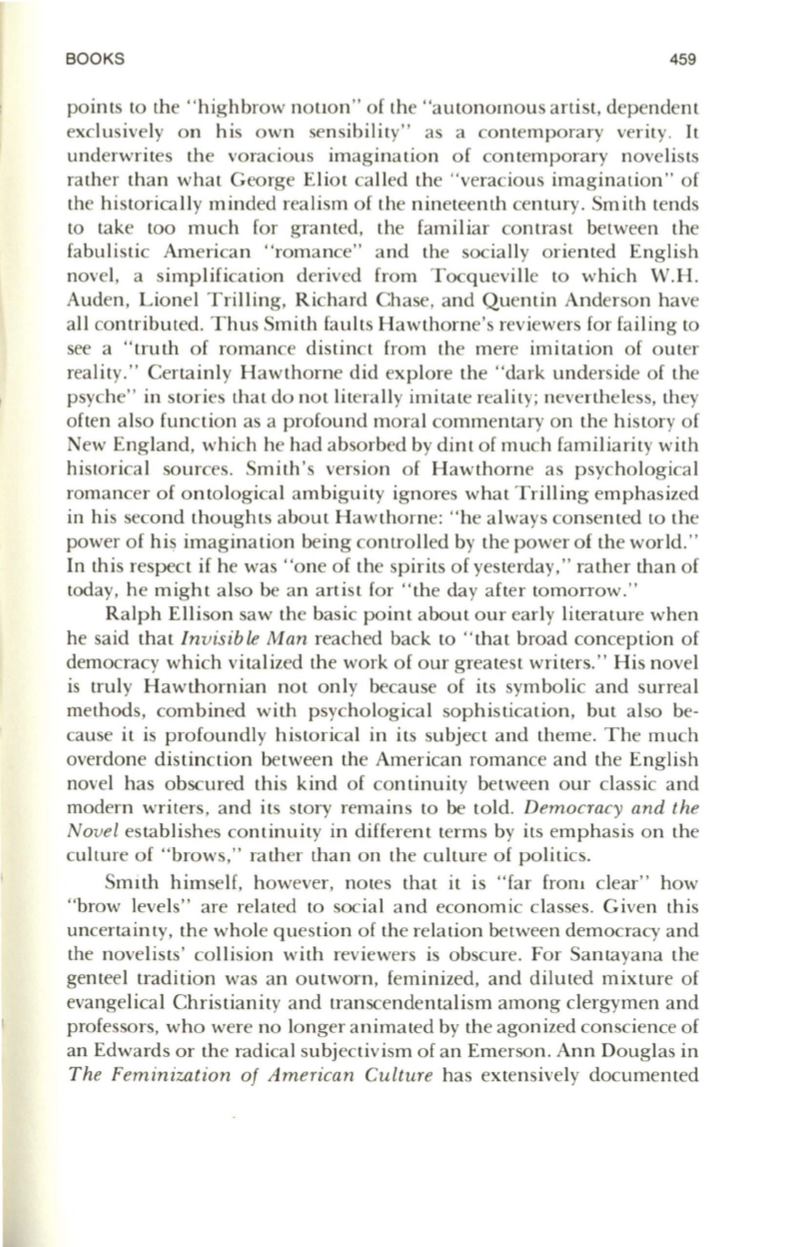
BOOKS
459
points to the "highbrow notIon" of the "autonomous artist, dependent
exclusively on his own sensibility" as a contemporary verity.
It
underwrites the voracious imagination of contemporary novelists
rather than what George Eliot called the "veracious imagination" of
the historically minded realism of the nineteenth century . Smith tends
to take too much for granted, the familiar contrast between the
fabulistic American "romance" and the socially oriented English
novel, a simplification derived from Tocqueville to which W.H.
Auden, Lionel Trilling, Richard Chase, and Quentin Anderson have
all contributed. Thus Smith faults Hawthorne's reviewers for failing to
see a "truth of romance distinct from the mere imitation of outer
reality." Certainly Hawthorne did explore the "dark underside of the
psyche" in stories that do not literally imitate reality; nevertheless, they
often also function as a profound moral commentary on the history of
New England, which he had absorbed by dint of much familiarity with
historical sources. Smith's version of Hawthorne as psychological
romancer of ontological ambiguity ignores what Trilling emphasized
in his second thoughts about Hawthorne: "he always consented to the
power of his imagination being controlled by the power of the world."
In this respect if he was "one of the spirits of yesterday," rather than of
today, he might also be an artist for "the day after tomorrow."
Ralph Ellison saw the basic point about our early literature when
he said that
Invisible Man
reached back to "that broad conception of
democracy which vitalized the work of our greatest writers." His novel
is truly Hawthornian not only because of its symbolic and surreal
methods, combined with psychological sophistication, but also be–
cause it is profoundly historical in its subject and theme. The much
overdone distinction between the American romance and the English
novel has obscured this kind of continuity between our classic and
modern writers, and its story remains to
be
told.
Democracy and the
Novel
establishes continuity in different terms by its emphasis on the
culture of "brows," rather than on the culture of politics.
Smith himself, however, nmes that it is "far froni clear" how
"brow levels" are related to socia l and economic classes. Given this
uncertainty, the whole question of the relation between democracy and
the novelists' collision with reviewers is obscure. For Santayana the
genteel tradition was an outworn, feminized, and diluted mixture of
evangelical Christianity and transcendentalism among clergymen and
professors, who were no longer animated by the agonized conscience of
an Edwards or the radical subjectiv ism of an Emerson. Ann Douglas in
The Feminization of American Culture
has extensively documented


